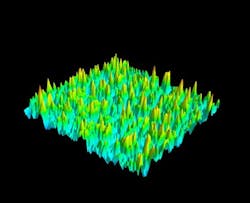Simplified x-ray phase contrast shows potential for clinical imaging applications
Using a laboratory source with unprecedented brightness, scientists from the Technical University of Munich (TUM) in Germany, the Royal Institute of Technology (Stockholm, Sweden), and University College London (UCL) in England have demonstrated a new approach to get reliable phase contrast with an extremely simple setup. The scientists are particularly interested in developing new approaches for biomedical x-ray imaging and therapy—including x-ray phase-contrast imaging. A future goal is to make this method available for clinical applications such as osteoporosis or cancer diagnosis.
Related: Lasers replace accelerator, magnets in device that makes synchrotron x-rays widely accessible
X-ray phase contrast imaging is a method that uses the refraction of x-rays through a specimen instead of attenuation resulting from absorption. The images produced with the method are often of much higher quality than those based on absorption.
In their new study, the scientists have now developed an extremely simple setup to produce x-ray phase-contrast images. The solution to many of their difficulties may seem counterintuitive: Scramble the x-rays to give them a random structure. These speckles, as they are called in the field, encode a wealth of information on the sample as they travel through it. The scrambled x-rays are collected with a high-resolution x-ray camera, and the information is then extracted in a post-measurement analysis step.
Using their new technique, the researchers have demonstrated the efficiency and versatility of their approach. "From a single measurement, we obtain an attenuation image, the phase image, but also a dark-field image," explains Dr. Irene Zanette, lead author of the publication. "The phase image can be used to measure accurately the specimen's projected thickness. The dark-field image can be just as important because it maps structures in the specimen too small to be resolved, such as cracks or fibers in materials," she adds.
The source's high brightness is also key to these results. "In the source we used a liquid metal jet as the x-ray-producing target instead of the solid targets normally used in laboratory x-ray sources," says Tunhe Zhou from KTH Stockholm, project partner of the TUM. "This makes it possible to gain the high intensity needed for phase contrast imaging without damaging the x-ray-producing target." To obtain all images at once, an algorithm scans the speckles and analyzes the minute changes in their shape and position caused by the specimen.
But not all components of the new instrument are products of the latest cutting-edge technology. To scramble the x-rays, "we have found that a simple piece of sandpaper did the job perfectly well," adds Zanette.
The researchers are already working toward the next steps. "As a single-shot technique, speckle imaging is a perfect candidate for an efficient extension to phase-contrast tomography, which would give a three-dimensional insight into the microstructure of the investigated object," Zanette explains.
Full details of the work appear in the journal Physical Review Letters; for more information, please visit http://dx.doi.org/10.1103/physrevlett.112.253903.
-----
Don't miss Strategies in Biophotonics, a conference and exhibition dedicated to development and commercialization of bio-optics and biophotonics technologies!
Follow us on Twitter, 'like' us on Facebook, and join our group on LinkedIn
Subscribe now to BioOptics World magazine; it's free!


